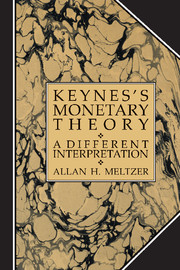Book contents
- Frontmatter
- Contents
- Preface
- 1 Introduction
- 2 Keynes in the 1920s: ideas, beliefs, and events
- 3 Theories, implications, and conjectures in the 1920s
- 4 The General Theory: a different perspective
- 5 Monetary reform and international economic order
- 6 Other interpretations of the General Theory
- 7 Conclusion
- References
- Index
3 - Theories, implications, and conjectures in the 1920s
Published online by Cambridge University Press: 05 September 2009
- Frontmatter
- Contents
- Preface
- 1 Introduction
- 2 Keynes in the 1920s: ideas, beliefs, and events
- 3 Theories, implications, and conjectures in the 1920s
- 4 The General Theory: a different perspective
- 5 Monetary reform and international economic order
- 6 Other interpretations of the General Theory
- 7 Conclusion
- References
- Index
Summary
The Treatise on Money is Keynes's major work on monetary theory during the 1920s. At the start of the work, he is a Cambridge quantity theorist, in the tradition of Marshall. His reservations about the quantity theory are not different in degree from those of many of his contemporaries. His basic beliefs, observations, and efforts to develop a dynamic theory led him in a different direction, one that he regarded as more useful.
The Treatise is a major work in more than one sense. Only a relatively small part of the book addresses the theoretical problem of fluctuations. Keynes chose to address large parts of monetary theory not closely related to his main theme. He begins by sketching his views about the nature of money and considers at length the measurement of prices by means of index numbers and the types of monetary standard. A separate volume applies the theory to historical episodes, to policy issues of his own day, and more generally to the management of money. In a fashion characteristic of much of Keynes's popular writing, he discusses and analyzes available data to bring out the main movements, to apply his theory, and to form his own and the reader's views about what is relatively fixed and what is more subject to change.
Although some parts, such as the discussion of index numbers and the analyses of events have outstanding sections, our main interest is the theory.
- Type
- Chapter
- Information
- Keynes's Monetary TheoryA Different Interpretation, pp. 61 - 114Publisher: Cambridge University PressPrint publication year: 1989



